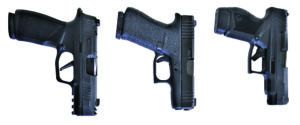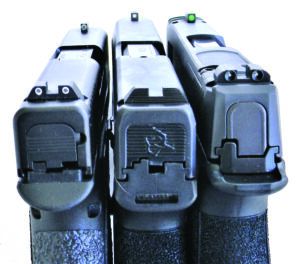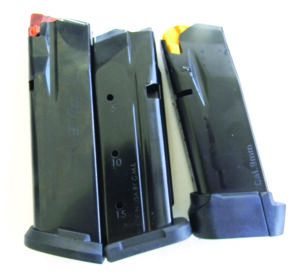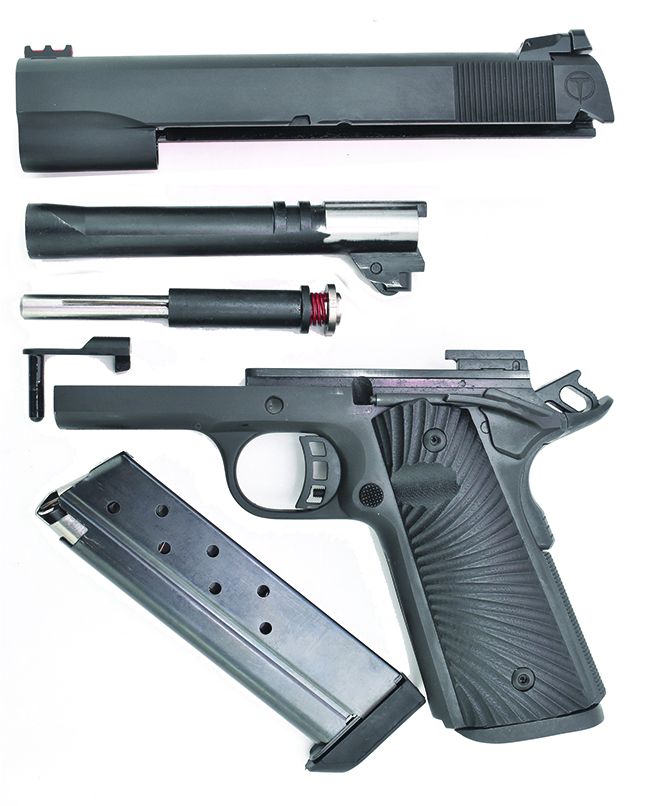In recent months, new versions of existing compact pistols have been introduced with new features and improvements. At least we hope the added expense and modifications are improvements. The trend is toward greater magazine capacity, improved sights, and sometimes a longer slide and barrel while maintaining a subcompact grip style.
The SIG P365 XMacro is perhaps the most modified of any of these new handguns with a compensator, larger grip, and the addition of grip inserts, not to mention a 17-round magazine. Similarly, Taurus took the GX4 and gave it a long slide similar to the SIG P365XL’s treatment. These seem like fitting improvements in shooting performance. Perhaps concealed carry is compromised slightly by longer barrels and magazines. Meanwhile, a custom operation known as Shield Arms has redesigned the magazine catch and magazines of the Glock 43X, offering 14-round steel magazines for the pistol. So to explore these new carry options, we faced off the two factory handguns and the Glock 43X converted to bigger magazines to see who would run.
Do you need the expensive SIG XMacro? Is the slightly longer slide of the Taurus beneficial? Should you simply modify the 43X to a higher capacity? In the end, one pistol answered these questions and stood above the others in combat ability, but another failed to function properly. Here’s what we found.
Gun Tests Grade: C
$400
In a rush to get the first GX4XL in the state, we probably paid $20 too much. Our version is not optics ready, with the Taurus Optics Ready Option (TORO) version costing $40 more. Taurus International has designed this as a head-to-head competitor with the SIG P365XL and Glock 43X/Glock 48 class, as well as the Springfield Hellcat. Taurus is able to offer the pistol at a lower price than most competitors charge for similar handguns.
| Action Type | Semi-auto, single action, locked breech |
| Overall Length | 6.43 in. |
| Overall Height | 4.2 to 4.4 in. |
| Maximum Width | 1.0 in. |
| Weight Unloaded | 20.0 oz. |
| Weight Loaded | 24.8 oz. |
| Barrel | 3.71 in. long, 1:10 RH twist, 6 grooves DLC-coated stainless steel |
| Slide | Gas-nitride-coated steel |
| Slide Retraction Effort | 14.0 oz. |
| Receiver Material | Black polymer |
| Grip | Textured black polymer, switchable |
| Grip Front Strap Height | 2.15 in. |
| Grip Rear Strap Height | 2.5 in. |
| Grip Thickness (Maximum) | 0.95 in. |
| Grip Circumference (Maximum) | 5.4 in. |
| Magazines | (2) 11 round |
| Rear Sight | Notch, drift adjustable steel |
| Front Sight | Fixed post, white dot |
| Sight Radius | 5.35 in. |
| Trigger Pull Weight | 6.0 lbs. |
| Trigger Span | 2.5 in. |
| Safety | Trigger lever |
| Warranty | Lifetime |
| Telephone | (800) 327-3776 |
| Website | TaurusUSA.com |
| Made In | U.S. |

The pistol features a single changeable backstrap and nitride-coated slide. The Taurus grip offers a good balance of adhesion and abrasion. The takedown sequence differs from most other compact pistols. A takedown screw in the right side of the frame is used to unlock the slide. After disassembly, when the slide is replaced, the screw simply snaps back into the locking mode. While different than most, it works well enough. Magazines are available with 10-, 11-, and 13-round capacities with the standard 11-round flush-fit magazines being superior for concealment, and the 13-round magazine offering a superior hold. This is less capacity than the other two handguns, but then the Taurus is more compact than the SIG.

Elsewhere, the pistol features low-profile fixed sights. We felt these sights provided a good sight picture. Forward cocking serrations are helpful in racking the slide. The sights are well regulated for the 115- and 124-grain loads used.
The GX4XL is a longer-slide version of the original Taurus GX4. The barrel length is stretched to 3.7 inches. This provides a longer sight radius for accuracy and also an average 40 fps advantage in velocity over the original Taurus GX4. Velocity was lower than the Glock 43X but higher than the SIG XMacro. The trigger is manageable, breaking at a clean 6.0 pounds, the heaviest of the test. The pistol seems well put together, with minimal slide-to-frame play.
The pistol was fired at 5, 7, and 10 yards with the same ammunition used in the other 9mm handguns. Recoil is manageable. The pistol seems more comfortable than the Shield/Glock but was not as easy shooting as the SIG. Combat accuracy was good, but not as good as the SIG. Results were very close to the Glock in combat shooting.

Firing from a solid bench rest position, the Taurus GX4XL proved accurate, firing five shots into a best 2.8-inch group, with groups bigger than 3.0 inches being more common. This is acceptable for combat.
The trigger is a single-action type, with a blade safety preventing discharge unless the lever is fully pressed into the trigger. During the test, we ran into a problem at 36 rounds fired. The trigger would not reset. We would fire, the slide would run to the rear, eject the spent case, and feed a new round, but the trigger would fail to reset. If we racked the slide manually, the trigger would reset, but not in normal firing. One of our raters is a competent gunsmith. He disassembled the pistol and remarked that sometimes a bit of grease will impede the trigger action. In this case he cleaned the pistol’s action and actually bent the trigger bar slightly because it was not connecting properly. The pistol was restored to function on the range.
Our Team Said: We have previously tested the GX4 9mm with good results. Two examples, a Standard and a TORO version, have not malfunctioned. This problem gave us pause. Most shooters would have had to return the pistol to Taurus and await the pistol’s return or eat a gunsmithing charge. It was also the least accurate handgun tested. We did not rate the pistol down on its 11-round capacity because we feel that the short grip and enhanced concealment made up for this.
9mm Luger Range Data
We fired five-shot groups at 25 yards from a benchrest position using an MTM Case-Gard K-Zone rest. We used a Competition Electronics Pro Chrony to measure velocity. The first screen of the chronograph was 10 feet from the muzzle of the firearms.| Federal Hydra-Shok 124-grain JHP | SIG P365 XMacro Comp | Taurus GX4XL | Glock 43X Conversion |
| Average Velocity | 1070 fps | 1109 fps | 1120 fps |
| Muzzle Energy | 315 ft.-lbs. | 339 ft.-lbs. | 345 ft.-lbs. |
| Small Group | 2.0 in. | 2.8 in. | 2.5 in. |
| Average Group | 2.45 in. | 3.5 in. | 3.1 in. |
| Black Hills 124-grain JHP | SIG P365 XMacro Comp | Taurus GX4XL | Glock 43X Conversion |
| Average Velocity | 1113 fps | 1130 fps | 1139 fps |
| Muzzle Energy | 341 ft.-lbs. | 352 ft.-lbs. | 357 ft.-lbs. |
| Small Group | 1.9 in. | 2.6 in. | 2.5 in. |
| Average Group | 2.5 in. | 3.1 in. | 3.0 in. |
| Remington 115-grain FMJ | SIG P365 XMacro Comp | Taurus GX4XL | Glock 43X Conversion |
| Average Velocity | 1125 fps | 1140 fps | 1154 fps |
| Muzzle Energy | 323 ft.-lbs. | 332 ft.-lbs. | 340 ft.-lbs. |
| Small Group | 1.7 in. | 2.9 in. | 2.5 in. |
| Average Group | 2.6 in. | 3.5 in. | 2.95 in. |




























